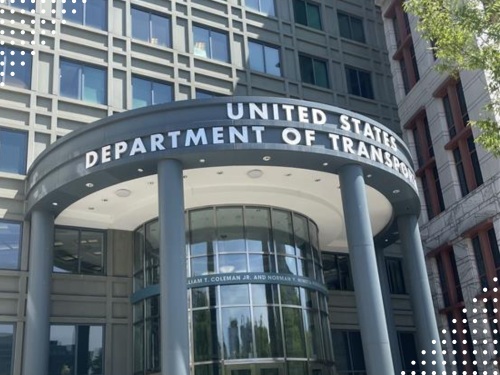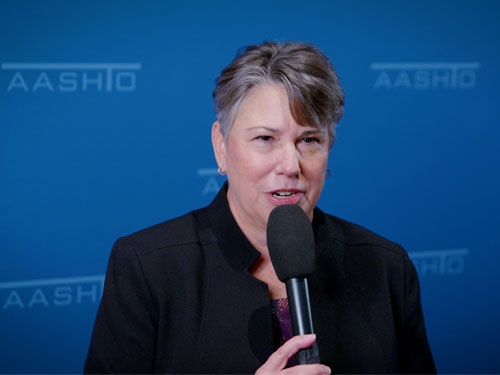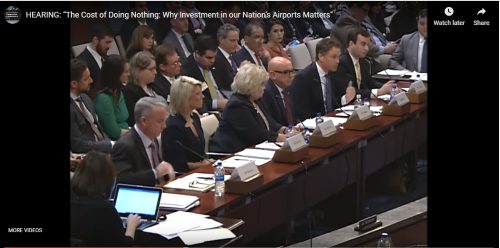Raising the passenger facility charges or PFCs added to airline tickets and increasing the amount of grant monies available through the Federal Aviation Administration’s Airport Improvement Program were key topics discussed during House of Representatives Transportation and Infrastructure Committee hearing held on March 26.
[Above photo via YouTube screen capture.]
“Crippling congestion has become the norm in our country. And it is not just on roads. This congestion is affecting air travel in the United States as well, with terminals clogged with passengers; runways and taxiways needing additions and rehabilitation; and airplanes sitting on tarmacs across the country waiting for gates,” noted Rep. Peter DeFazio, D-Ore., chairman of the T&I committee, in his opening statement.

“Passenger terminals across the United States, many of which were constructed in the 1960s or 1970s, are outdated and cannot accommodate current or projected passenger growth,” he added. “In addition, airports do not have the space or gates needed to accommodate current airline departures and arrivals, let alone for welcoming new service for communities. This, in turn, affects the price you pay for an airline ticket, as well as local businesses and regional economies from coast to coast.”
Rep. DeFazio noted that PFC has been capped at $4.50 per passenger since 2000 and argued that it should be increased. “A priority for me as chairman this year will be to increase the cap on the PFC so that U.S. airports can keep pace with current demands as well as plan for expected commercial service growth in the years ahead,” he said.

However, Rep. Sam Graves, R-Mo., ranking member on the T&I committee, said in his remarks that “aviation is different” when it comes to infrastructure funding as “tens of billions of dollars over the past few years have been poured into our airports [and] last year, Congress authorized nearly $4.5 billion annually in airport grants while making it easier for airports to use PFC revenues.”
He argued that “in terms of an infrastructure package, all funding options are on the table, but I am skeptical of any proposal that adds to the traveling public’s burden, fails to fully consider the views of local communities and passengers, and lacks a full range of financing options, including private capital.”

Lawrence Krauter, CEO of Spokane International Airport and Felts Field & Airport Business Park and one of the witnesses at the hearing, stressed in his remarks that adjusting the “outdated” federal cap on local PFCs would allow airports to finance a greater share of their projects with local user-fee generated revenue. Further, he said increasing AIP funding would enable smaller airports to afford upgrades.
“Adjusting the PFC cap and increasing AIP funding would help Spokane International Airport and other small airports around the country renovate or replace aging terminal facilities and keep up with rising passenger growth, increasing construction needs, and construction cost inflation,” he explained.

“Moreover, increases in commodity costs – such as steel – and shortages of construction labor are driving up the cost of capital projects for airports throughout the country,” he added. “These factors are outside our control as they are driven by national policy actions.”
Marc Scribner, senior fellow with the Competitive Enterprise Institute, supported Krauter’s view at the hearing in regards to raising the PFC, stressed that changes to the AIP are needed to boost airport efficiency.
“Together, the PFC and AIP account for approximately half of total airport funding available for capital projects,” Scribner explained in his remarks.

“Evidence suggests that PFC use has a positive effect on airport productive efficiency, while AIP use has a negative effect. Recent research has found that increasing airport reliance on PFC revenue while simultaneously decreasing airport reliance on AIP revenue increases airport productive efficiency,” he said. “The implication is that leaving the PFC cap at the current $4.50 while increasing AIP funding by spending down the unobligated funds in the Airport and Airway Trust Fund would have a negative efficiency impact.”
Scriber suggested that eliminating the PFC cap, requiring 100-percent AIP funding turn-back for charges over $4.50, and proportionately reduce the total annual AIP authorization by $400 million would not only reduce federal spending and promote local self-help, it would “raise airport productivity.”
 Top Stories
Top Stories
USDOT Makes $1.5B Worth of BUILD Grants Available
December 19, 2025 Top Stories
Top Stories

